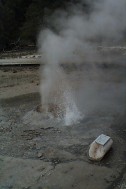Maybe it's because I've been gone for a while, but these past few weeks I've heard some geyser gazers I've not seen before using terms I've never heard of, terms that aren't needed, terms about a geyser which I know extremely well.
I've always heard of Grand's eruptions being referred to as being a "one burst", or "two burst", or "three burst" or even "eight burst" eruption. Yet there are people using terms like "single" or "double" or "triple" to describe the number of bursts in an eruption. That's just wrong, and not just because I don't like it.
It's not just because I have proprietary feelings towards that part of the basin. The terminology for Grand eruptions has been long established, I would assume by Marie Wolf or Suzanne Strasser, or even someone earlier. There is no reason to change that terminology. For one thing, if a miracle occurred and Grand went back to the pre-1960s type eruptions with up to a couple dozen bursts, or if one just wants to refer to eruptions from that era, that terminology breaks down, or at least becomes very silly.
Besided "double" and "triple" and such implies equality between the bursts, which is not the case. The first burst, at least during the last few decades, is decidedly different, and plays a different role in the eruption, as witnessed by its length. And "double" implies the full term, "double eruption", which makes no sense. Compare that to "one burst eruption", which makes sense as either " one burst" or even "one", as in "Grand had another one this morning."
Proper communication requires using agreed upon terms and other criteria. Using multiple terms for the same phenomena serves only to confuse.
Sit around the basin long enough, and you will inevitably witness this scenario: A family walks by, and one of the children gives a silly name to a feature. An adult compliments them, even though there's a sign right in front of them. They are on vacation, none of this really maters, and it'll all be forgotten within the hour.
I can understand the desire to want to name things, or the misguided attempt to clarify unnecessarily, as seems the case here. But if a person really wants to do that, they should at least put in the effort to demonstrate why the change is necessary, and to persuade others, not just off and start using new terms used by no one else (especially one not used by those who have studied the feature and become fairly knowledgeable about it.) Doing that is little more than the tourist family giving out pet names.

